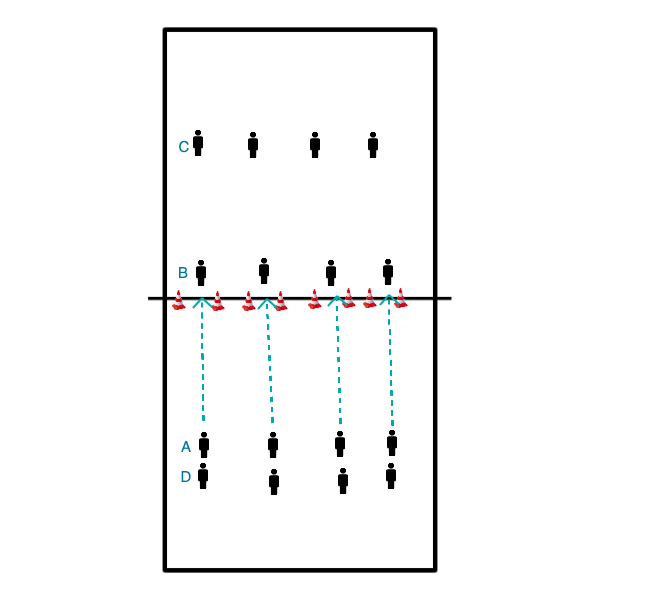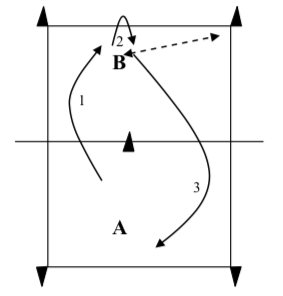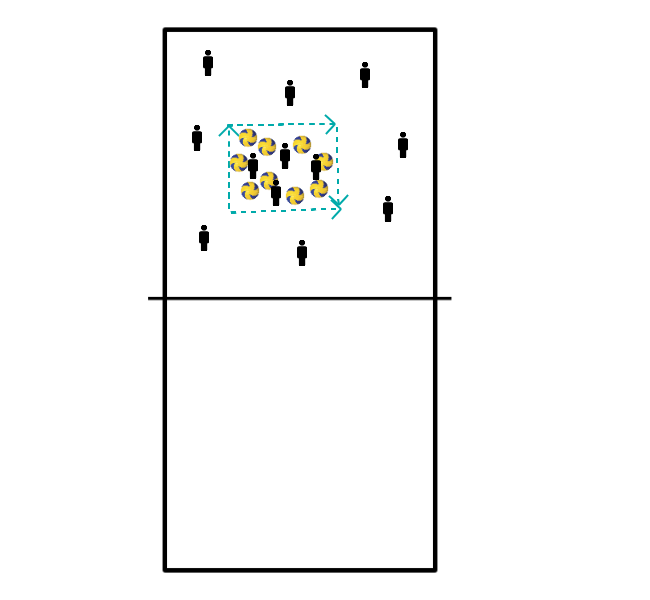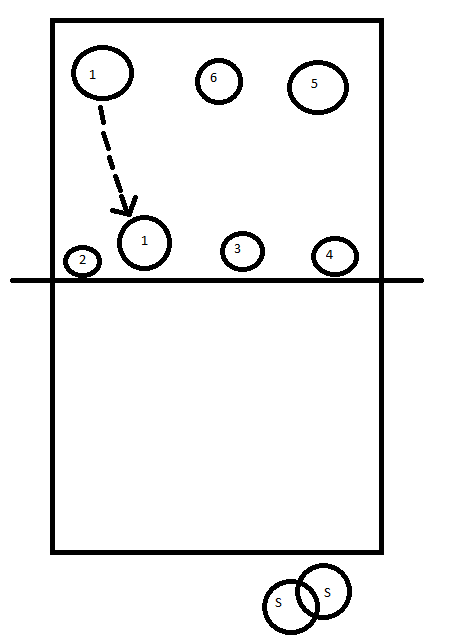Volleyball drills
- Everyone lines up in a plank position.
- The first person in the row
- rolls the ball under the others,
- goes to the other end of the line,
- rolls the ball back and joins them in plank position.
- The new first person takes the ball and does the same.
- In this way the different groups have to cover a certain distance as quickly as possible.
Formation: 2 balls per 4 players

1.
- Player A (bowling motion) rolls the ball to player B (the ball must pass between the 2 cones!!).
- Player B picks up the ball, bounces it 2 times and then plays it in a bow to player C.
- Player C holds a hoop and puts the hoop down at the spot where the ball is going to collide. The ball is caught after 1 collision. Player C grabs the ball and joins player D at the back.
- Everyone follows their ball = moves up one place.
2.
- Player A throws the ball under the net to player B.
- Player B catches the ball, bounces once high, does a control key and then bounces to player C.
- Player C catches the ball low to the ground in the correct reception position and runs to D to join the back of the line.
- Everyone follows their ball = moves up one spot.
3.
- Player A throws the ball (bowling motion!) over the net to player B.
- Player B plucks the ball out of the air, bounces 3 times (must turn around during those 3 bounces to face player C) and then tips the ball to player C.
- Player C does reception for himself and joins player D.
- Everyone follows their ball = moves up one spot.
4.
- Player A calmly strikes the ball underhand over the net to player B.
- Player B plucks the ball out of the air, does 1 control bounce, then does control keys until fully turned facing player C and then plays the ball player C.
- Player C does reception for himself, catches the ball and joins player D.
- Everyone follows their ball = moves up one spot.
In a line-up with 2 players facing each other, key the ball over the net after 2 dribbles and 1 high rebound.

Possible variations:
- Play the ball after bumps
- Playing the ball after picking
- Playing the ball after catching without bots
- Play with 2 balls
Note: depending on the level we can differentiate and let the better players play with a handicap.
Setup: 2 to 4 people in the square (made by, for example, 4 benches) with the balls, the rest around them.

- The people in the square throw the balls out of the square.
- The people around the square fetch the balls and throw/put them back in the square.
- The 'side' which, at the stop signal, has the least balls, has won.
variation on Kings Court: winners move to winners field, losers move out and 3 new players move in.
- 3 players per half (whole field)
- trainer puts 1st ball in field of new team
- max 2 plays per half
- no smashing, no jumping, no lobs
- communication per team is a necessity
- The whole field must be defended (is feasible).
- balls coming from the other side are not hard but placed.
- player1 throws in from behind the net:(3players)
- 2 teams on the back line on the stomach
- Player1 hits the ball, 2 players stand up and coach attacks one of the pair defends, nr. 2 sets up and nr. 3 attacks
- after that next 2 team player1 with player 2 etc.
- 2x around the field
- 3 times back and forth in a running pace to the net
- 3 times back and forth in runner's stride to the net, waving your arms while walking
- Cross walk to the net 3x (waving your arms along)
- 3x back and forth sideways to the net (arms swinging)
ON 1 FIELD:
- groups of3/4/5
- 2 groups per field
- 1 group bats, after the serve the person who bats starts to run around the bases around the field (baseball)
- the other group is on the opposite side: 3 persons defend, 1 person catches on position 3
- the defenders have to get the ball to the receiver as soon as possible, when the receiver has the ball in his hands, he will call loudly stop and everybody has to stop walking
- when the server lands in the net or the runners have not reached a base in time, they are out and must wait until the changeover to play again
- when the server hits an ace, this is a homerun: the same goes for when the defenders punt the ball away
- the catcher of the defending team must stand on a mat and may not leave the mat to catch the ball
- when the attacking team has 3 players out, it is a change.
- if you are playing with 3 people, the substitution takes place when 2 people are out, if you are playing with 5 people, the substitution takes place when 3 people are out.
Everyone has a ball.
Various exercises:
- Playing ball for themselves underhand.
- Play ball for oneself overhead.
- Play ball for oneself underhand with only the left arm.
- Play ball for yourself underhand with only the right arm.
- Play ball for self overhead with only the left hand.
- Play ball for oneself overhead with only the right hand.
- Play ball for oneself overhead and underhand alternately.
- Line up for trainer, trainer at the net.
- Player throws the ball, trainer plays/throws it back.
- Then player passes to trainer.
- Trainer throws the ball over the net.
- Player retrieves ball and closes in back.
- NB! Ball speed is increasing until ball is hit.
- On 2 sides a team of 6 in the field.
- On 1 side a thick mat against the net.
- They hit/attack against it.
- The ball comes back (=block); dissolve in the field --> 2nd attack on midfield.
- Players on the other side play this ball.
- Ball is served.
- Pass by 1/5/6.
- Set-up by 1, but on a first pass by 1 set-up by 2.
- After set-up an attack by 2/3/4, but on a set-up by 2 only an attack by 3/4.
- After service 2 (or more) players walk into the court to play.
- Ball/ralley is played all the way out.
- NB: FOCUS IS ON THE SERVICE PASS!








